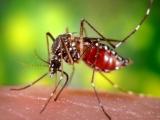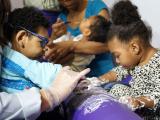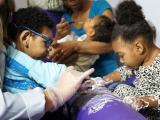The US Centers for Disease Control and Prevention (CDC) today updated its Zika-related travel advice to exclude destinations above 6,500 feet (2,000 meters), as Aedes mosquitoes, which transmit the virus, are rare in those locations.
In related news, the Pan American Health Organization (PAHO) reported yesterday that Zika infections seem to be increasing in Venezuela and Panama and throughout the Americas overall. The agency also detailed how it is ramping up its mosquito-control efforts.
Region-specific advice by elevation
For 37 travel destinations for which the CDC had already issued level 2 travel alerts (meaning visitors should practice enhanced precautions), the agency today added elevation maps showing areas above 6,500 that are exempt from level 2 precautions, including for pregnant women (see Mexico map, below).

"CDC recently examined historical reports of the mosquito species linked to Zika and dengue virus, which is spread by the same mosquito, and found that reports of both mosquitoes and dengue were rare for locations above 6,500 feet," the agency said in a press release.
CDC scientists conducted spatial analyses using data on Aedes aegypti from 1960 through 2014 and for human dengue cases from 1960 through 2012 for 16 countries, according to an accompanying report today in Morbidity and Mortality Weekly Report (MMWR). For each country the mosquito species was largely absent above 6,500 feet. And only 1.1% of dengue cases reportedly occurred above that elevation.
"These findings support revising the Zika travel notice to reflect enhanced geographic precision regarding the likelihood of Zika virus presence at certain elevations," the authors of the report note.
The report also says, "With this revision, CDC recommends that women who are pregnant should postpone travel to areas that are at elevations <2,000 m above sea level in countries and U.S. territories with ongoing Zika virus transmission."
The agency said of the country- or territory-specific maps, "The maps are intended to help travelers determine if the location(s) they plan to visit are above the elevation at which the mosquitos are likely to be found. Travelers whose itineraries are limited to areas above 6,500 feet are at minimal risk of getting Zika from a mosquito."
Mexico City and Bogota, Colombia, for example, are both above 6,500 feet and would involve minimal risk of contracting the virus.
The CDC adds in its news release, "Although the Zika-associated mosquitos are likely not found at these higher elevations, mosquitoes are not the only way that Zika virus is spread. Sexual transmission is also possible." The virus has also been detected in saliva and urine, but no spread has been documented from contact with those bodily fluids.
The agency recommends that travelers visit the CDC's Zika Web site and speak with a healthcare provider before traveling to Zika-affected areas. It also recommends taking precautions when traveling to reduce the risk of mosquito bites.
Increases in Venezuela, Panama
PAHO reported yesterday in an epidemiologic update that Zika cases in Venezuela and Panama appear to be on the rise, but those in El Salvador and Honduras may be tapering.
"Nevertheless, as the geographical range of the virus expands to new areas, the overall epidemic appears to be increasing in the Region of the Americas," the agency said.
Of 16,942 Venezuelans with suspected cases, 941 involve pregnant women, PAHO said. And among 226 who were sampled, 153 tested positive. The country has noted one case of microcephaly (smaller-than-normal head), but the baby tested negative for Zika virus.
Mosquito control ramp-up
In related news, a new Technical Advisory Group on Public Health Entomology is looking at ways to strengthen vector control programs in affected countries, including specific measures for combating A aegypti, PAHO said today in a news release. The announcement comes after a 3-day meeting at PAHO headquarters in Washington, D.C.
The advisory group is chaired by Karen Polson-Edwards, PhD, of the Caribbean Public Health Agency, and includes experts in entomology, vector control, neglected diseases, epidemiology, and insecticide resistance management. It advises PAHO Director Carissa Etienne, MD, on ways to strengthen surveillance, control, and elimination of vector-borne diseases.
"Vector control is the best way we have of combating these diseases," Polson said in the PAHO release. "Entomology and vector control works, if used and applied correctly by countries."
"Our most important tool to combat Zika—and at the same time, dengue and chikungunya—is control of the Aedes aegypti mosquitoes that transmit these diseases," said Dr. Luis Castellanos, MD, PhD, chief of neglected, tropical and vector-borne diseases at PAHO. "Since these mosquitoes live in and around houses, this will take a concerted effort with intensified community engagement to reduce the number of mosquitoes in the Americas.
"We are also looking urgently at improving control methods including insecticides and other new technologies."
See also:
Mar 11 CDC news release
Mar 11 MMWR report
CDC travel notices
Mar 10 PAHO epidemiologic update
Mar 11 PAHO press release





















